High Level Summary of Equality Statistics: Key Trends for Scotland 2006
The High Level Summary of Equality Statistics is a compendium which presents statistical trends on the main areas of Government activity in Scotland across a number of equality dimensions including age, disability, ethnicity, gender and in some cases religion. It provides a standardised, concise format for each topic and provides a route into more detailed statistics on each topic and each equality dimension by listing relevant publications and websites.
9. Health & Community Care
Introduction to Health & Community Care and Equality
This section of the High Level Summary of Equality Statistics ( HLSES) presents key information on health and community care in Scotland across a number of equality dimensions including age, disability, gender and ethnic group in a small number of cases. It reflects key areas of activity identified in the main High Level Summary of Statistics ( HLSS) chapter on health and community care ( http://www.scotland.gov.uk/Topics/Statistics) from an equalities perspective and includes a few additional topics where these are particularly relevant to equality issues. Where the main HLSS publication presents data by any of these equality dimensions, these are also shown here for ease of reference.
As well as showing key high level trends, the analysis highlights where differences and potential areas of inequality may exist for health and community care in Scotland for those groups outlined above. The analysis is not intended to provide a definitive set of equalities data and more detailed statistics across the equality dimensions, where available, are referenced in the links provided. It is also not possible to break down all topics by all equality dimensions.
There are limitations in how far some data can be broken down by the above equality dimensions. Data often contain small numbers, particularly in the case of smaller ethnic groups and to some extent disability. As such, some data show a high degree of volatility. In such instances, data may have been combined for multiple years or multiple ethnic groups, whilst in other cases data may be shown for a single year only. In other instances small data may have been suppressed in order to protect individuals' confidentiality
Data on health and community care are not always collected for disability and ethnicity to the same extent as for age and gender. This fact is reflected in the range of data that can be provided in this chapter. Some links to research and information on health in relation to ethnic groups are provided at the end of this chapter.
Possible reasons underlying the differences reported in this chapter are not detailed here. Factors which contribute to differences between equality groups represent a complex interplay of cultural, demographic and socio-economic factors and, as such are outwith the scope of this publication.
Life Expectancy
Life Expectancy: Gender
Life expectancy; the number of years that a person can expect to live on average, is a single measure of population health which is used to monitor public health, health inequalities, the outcome of health service interventions and to allocate resources.
Life expectancy ( LE) at birth for Scots continues to improve, and recent trends show a slight narrowing of the gap between males and females to around 5.3 years in 2002-2004 (males now having life expectancy at birth of 73.8 years compared with 79.1 for females). However LE in Scotland remains low compared with most Western European countries. In terms of quality of life, healthy life expectancy (Healthy LE) at birth (based on Self-Assessed Health) has also increased over the longer term but at a lower rate than the increase in overall life expectancy. The gap between life expectancy and healthy life expectancy is greater for women than for men, suggesting that they spend more years in poor health.
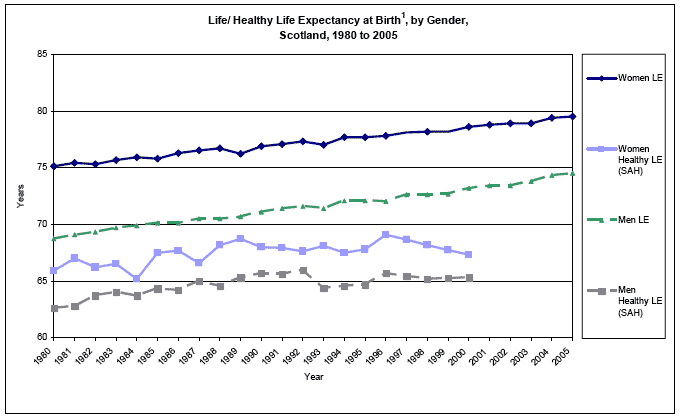
Sources: Health life expectancy data are taken from the "Healthy Life Expectancy in Scotland" Report. Life expectancy data are from the Government Actuary Department ( GAD)
Notes: 1. Estimates of Health LE depend on the way good health is defined, and on the source of the health status data used in theses calculations. The two main approaches to defining good health used for these data are: i) use of limiting longstanding illness ( LLI), where 'good health' is defined as reporting the absence of LLI, and ii)use of self-assessed general health status ( SAH), where 'good health' is defined as reporting health as 'good' or 'fairly good'
Publications
Social Focus on Women and Men 2002 http://www.scotland.gov.uk/stats/sfwm/docs/sfwm-00.asp
Healthy Life Expectancy in Scotland (Executive Summary) (Published 2004) http://www.isdscotland.org/isd/files/HLE%20_exec_summary.pdf#search='healthy%20life%20expectancy'
Healthy Life Expectancy in Scotland (Full Report), March 2004 (Published 2004) http://www.isdscotland.org/isd/files/HLE_report_2004.pdf
Web Link
Government Actuary Department ( GAD) http://www.gad.gov.uk/Life_Tables/Interim_life_tables.htm
Mortality Rates
Mortality Rates: Gender
Part of the increase in overall life expectancy for males and females stems from the impact of improvements in lifestyle, and in healthcare provision, on reducing premature mortality from the three big killers: cancer, coronary heart disease ( CHD) and stroke. Nevertheless enduring gender differences in premature mortality remain, largely in respect of cancer and CHD.
The mortality rate for cancer for males under 75 is 159 per 100,000 in 2005, compared to 126 per 100,000 for females. Mortality rates for CHD for males under 75 is 102 per 100,000, compared 36 per 100,000 for females. Mortality rates for stroke do not differ substantially for males and females.
Mortality rates for CHD and cancer have decreased substantially, for both males and females since 1999, with the gap between male and female rates reducing greatly for CHD. Mortality rates for stroke have also decreased, though less markedly.
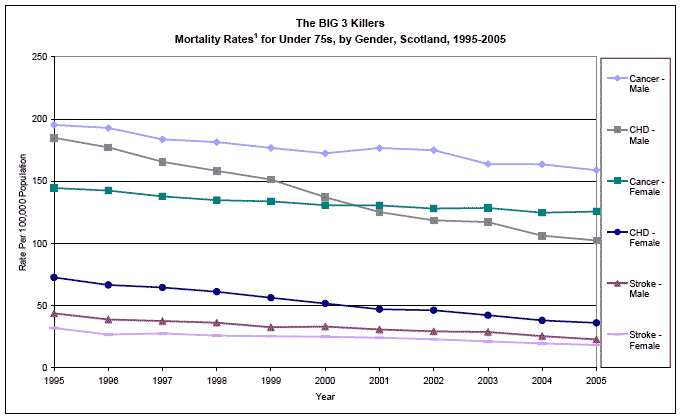
Source: General Register Office for Scotland ( GROS)
Note: 1. Standardised to the European Population.
Publication
Social Focus on Women and Men 2002 http://www.scotland.gov.uk/stats/sfwm/docs/sfwm-00.asp
Mortality Rates: Age & Area Deprivation
The following data are based on the Scottish Index of Multiple Deprivation ( SIMD) 2006.
Life expectancy in the 10% least deprived areas is higher than in the 10% most deprived areas and deaths in the under 75 age group account for 53% of all deaths in the 10% most deprived areas, compared to 31% of all deaths in the 10% least deprived areas in 2003 to 2005 (combined).
The average annual number of deaths for those aged between 20 and 49 years account for 10% of all deaths in the 10% most deprived areas, compared to 4% of all deaths in the 10 least deprived areas.
As would be expected the percentage of all deaths in both groups increases as age increases. However, from the age of 75 years onwards the proportion of all deaths in the 10% most deprived areas is lower than in the 10% least deprived areas reflecting the fact that people in the 10% most deprived areas tend to die younger than those in the 10% least deprived areas. Similarly from the age of 80 years onwards the percentage of all deaths in the 10% least deprived areas shows a sharp increase in comparison to the percentage of all deaths in the 10% most deprived areas and reflects the fact that people in the 10% least deprived tend to live longer and die later.
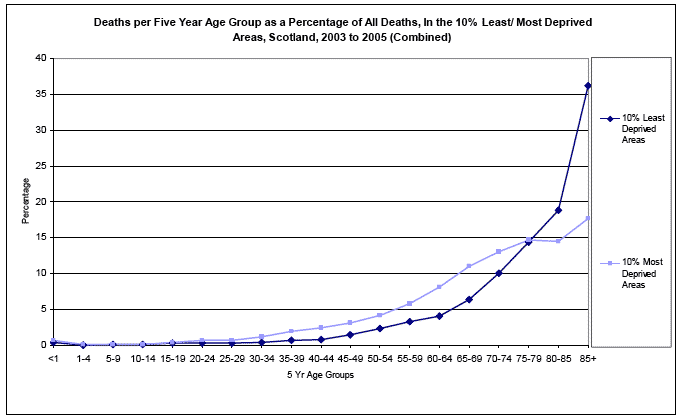
Source: Deaths data - Information and Statistics Division ( ISD) Scotland
Deprived areas data - Scottish Index of Multiple Deprivation ( SIMD) 2006
Publication
Social Focus on Deprived Areas 2005 http://www.scotland.gov.uk/SocialFocusonDeprivedAreas
Web Link
Scottish Index of Multiple Deprivation ( SIMD) http://www.scotland.gov.uk/SIMD
Diet
Diet: Age & Gender
The White Paper on health 'Towards a Healthier Scotland' published in 1999, stated that Scotland's diet is a major cause of poor health in the country. The Scottish diet is traditionally high in fat, salt and sugar, and low in fruit and vegetables.
A recent review of dietary progress 1 has indicated that although some progress has been made towards reducing total fat intake since 1996, there has been no change in the intake of saturated fat, fruit and vegetables, bread, oil rich fish and breakfast cereals. Furthermore the data indicate that there appears to have been an increase in the consumption of non-milk extrinsic sugars (i.e. sugars not found in dairy products, for example honey, fruit juices, table sugar and confectionery are all examples of non-milk extrinsic sugars. These are sometimes called added sugars).
According to the Scottish Health Survey 2003, a slightly higher proportion of women than men eat 5 portions or more of fruit or vegetables per day, across most age group. Men aged between 55 and 64 years are most likely to eat 5 portions or more of fruit or vegetables per day (24% of all men in this age group), whilst women aged between 45 to 54 years and 55 to 64 years are most likely to eat 5 portions or more of fruit and vegetables per day (27% of women in both groups).
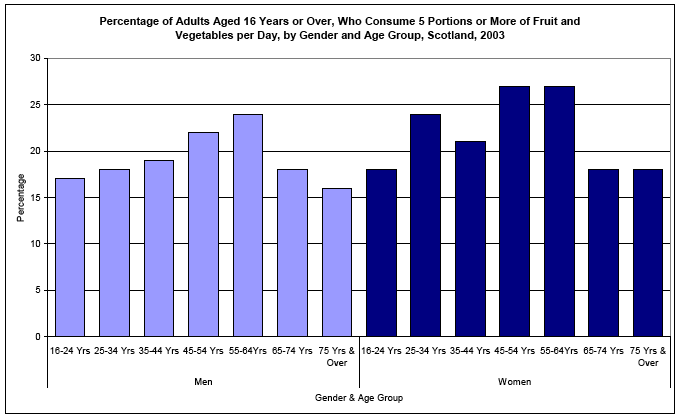
Source: Analytical Services Health, Scottish Executive
Publications
Social Focus on Women and Men 2002 http://www.scotland.gov.uk/stats/sfwm/docs/sfwm-00.asp
Scottish Health Survey 2003 http://www.scotland.gov.uk/Publications/2005/11/25145024/50251
Reference
1. Wrieden WL, Barton KL, Armstrong J, McNeill G.A Review of Food Consumption and Nutrient Intakes From National Surveys in Scotland: Comparison to The Scottish Dietary Targets. Available on the Food Standards Agency Web site by mid July 2006 ( http://www.food.gov.uk/scotland/).
Obesity
Obesity: Age & Gender
Body Mass Index ( BMI) is the most commonly accepted measure of general obesity. BMI is defined as (kg) divided by height (m 2). Adults are classed as overweight if their BMI is 25 or greater, and obese if their BMI is 30 or greater.
The 2003 Scottish Health Survey estimates that in Scotland around 24% of men and 27% of women are obese. In general, the prevalence of obesity increases with age for both males and females.
There has been a marked increase in the prevalence of obesity since 1995 when just 16% of men and 19% of women were obese.
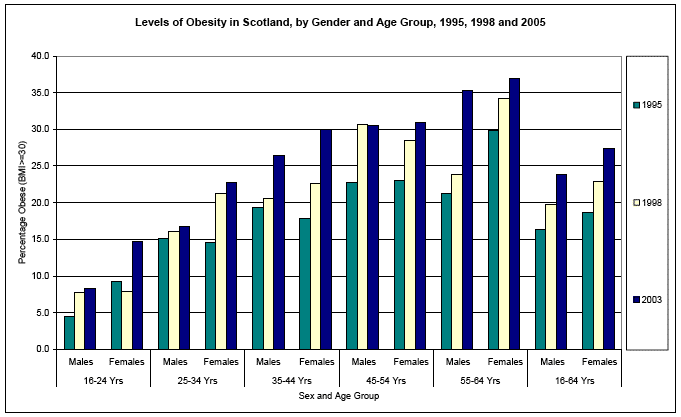
Source: Scottish Health Survey
Publications
Social Focus on Women and Men 2002 http://www.scotland.gov.uk/stats/sfwm/docs/sfwm-00.asp
Scottish Health Survey - 2003 results (Published 2005) http://www.scotland.gov.uk/Publications/2005/11/25145024/50251
Physical Activity
It should be noted that definition of recommended activity levels used in Health Education Population Survey ( HEPS) presented below differs slightly from the definition used in the Scottish Health Survey (data from which are used elsewhere in this publication). As such the data are not directly comparable.
Physical Activity: Gender
The Health Education Population Survey ( HEPS), which samples adults aged 16 to 74 years old in Scotland, has found generally low levels of physical activity in Scotland, with most men and women failing to achieve recommended levels of activity (defined in the HEPS as at least five sessions of moderate activity per week ( one session of moderate activity would last 30 minutes and where breathing would be faster than normal through physical exertion) or at least three sessions of vigorous activity per week (one session of vigorous activity would last 20 minutes and activity would induce sweating or being out of breath)).
For men, there has been a slight increase between 1996 and 2004 in the numbers achieving the recommended levels, although there is no definitive trend over time given the volatility of the sample data (as shown below). The percentage achieving the recommended levels is consistently higher for men than women.
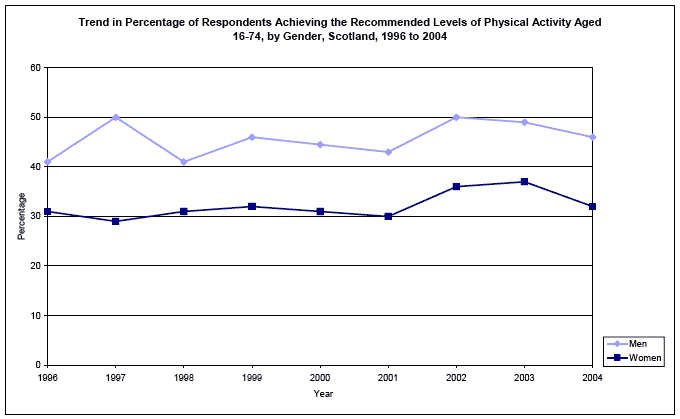
Source: Health Education Population Survey ( HEPS)
Publications
Social Focus on Women and Men 2002 http://www.scotland.gov.uk/stats/sfwm/docs/sfwm-00.asp
Health Education Population Survey ( HEPS) http://www.hebs.scot.nhs.uk/researchcentre/pdf/RE045Final2004.pdf
Physical Activity: Age
The Health Education Population Survey ( HEPS), which samples adults aged 16 to 74 years old in Scotland, has found that levels of recommended physical activity in Scotland tend to decline with age and are fairly low for each age group (recommended physical activity is defined in the HEPS as at least five sessions of moderate activity per week ( one session of moderate activity would last 30 minutes and where breathing would be faster than normal through physical exertion) or at least three sessions of vigorous activity per week (one session of vigorous activity would last 20 minutes and activity would induce sweating or being out of breath)). These patterns have been fairly consistent over time.
In 2005, HEPS estimates that 51% of 16 to 24 year olds were achieving recommended levels of physical activity. This compares to 38% of those aged between 45 and 54 years and 25% of those aged between 65 and 74 years.
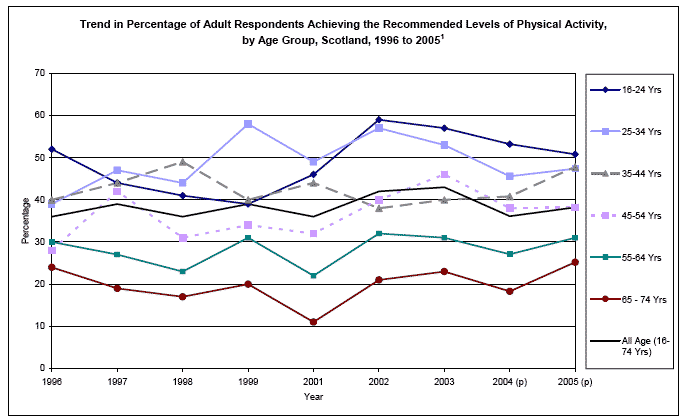
Source: Health Education Population Survey ( HEPS)
Note: 1. Figures for 2000 are not available.
p = provisional.
Publication
Health Education Population Survey ( HEPS) http://www.hebs.scot.nhs.uk/researchcentre/pdf/RE045Final2004.pdf
Smoking
Smoking: Age & Gender
The prevalence of smoking in both males and females is relatively similar for those aged between 16 and 59 years and then begins to decrease at age 60 years and over.
According to the Scottish Household Survey, the prevalence of smoking among males is estimated to be highest in those aged 25 to 34 years (36%) in 2005, whilst for females it is highest for the age bands 25 to 34, 35 to 44, and 45 to 59 (29%, 29% and 30% respectively).
Between 2003 and 2005, the prevalence of smoking is estimated to have decreased most for males aged 60 to 74 years for both males (a fall of 4 percentage points) and for females aged 16 to 24 years (a fall of 4 percentage points).
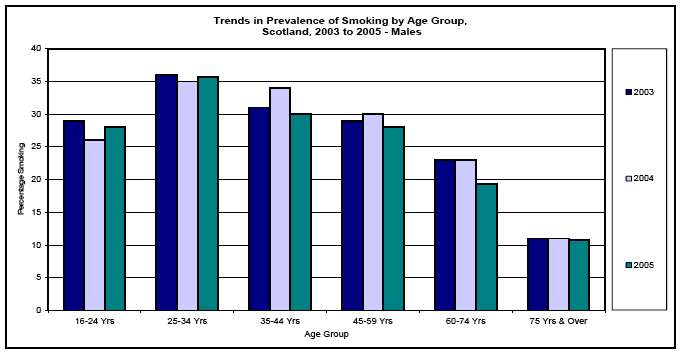
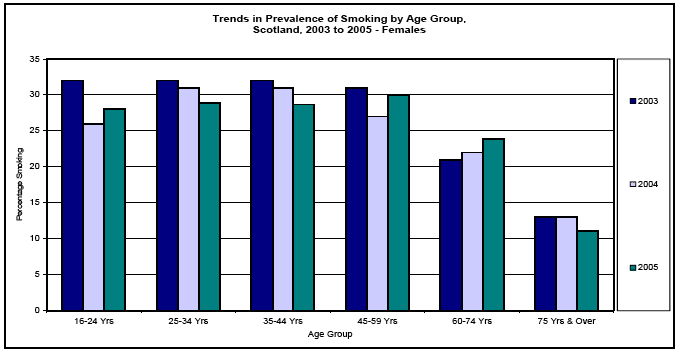
Source: Scottish Household Survey
Publication
Social Focus on Women and Men 2002 http://www.scotland.gov.uk/stats/sfwm/docs/sfwm-00.asp
Web Link
Scottish Household Survey http://www.scotland.gov.uk/Topics/Statistics/16002/4031
Smoking: Ethnic Group
It is estimated that the prevalence of smoking among white ethnic groups is higher than for minority ethnic groups.
Prevalence of Smoking by Combined Ethnic Group 1, Scotland, 1999 to 2004 2
Percentage
Combined Ethnic Group |
Scotland |
|||||
|---|---|---|---|---|---|---|
1999 |
2000 |
2001 |
2002 |
2003 |
2004 |
|
White Ethnic Groups |
31 |
29 |
28 |
28 |
28 |
27 |
Minority Ethnic Groups |
19 |
16 |
n/a |
n/a |
17 |
18 |
Source: Scottish Household Survey
Notes: 1. Some percentages are based on counts of 200 or less and should therefore be treated with caution.
2. Data on smoking for minority ethnic groups are not available on the SHS for 2001 and 2002 due to date quality issues.
n/a = not available.
Publications
Analysis of Ethnicity in the 2001 Census - Summary Report http://www.scotland.gov.uk7ff5ee0f-3801-4607-b42e-2fbe7a66bf2d
Scottish Household Survey http://www.scotland.gov.uk/Topics/Statistics/16002/4031
Smoking: Disability
The Scottish Household Survey ( SHS) estimates that the prevalence of smoking is slightly higher in adults with a disability and/ or long term illness compared to those with no disability and/ or long term illness and this appears to be fairly consistent over time.
In 2005, the SHS estimates that 33% of adults with a disability and long-term illness smoke, compared to 30% of those with a disability only, 29% of those with a long-term illness only and 25% of those with no disability or long-term illness.
Prevalence of Smoking by Disability Status, Scotland, 2001 to 2005
Percentage
Disability Status |
Prevalence of Smoking |
||||
|---|---|---|---|---|---|
2001 |
2002 |
2003 |
2004 |
2005 |
|
Disability Only |
31 |
32 |
30 |
28 |
30 |
Long-Term Illness Only |
32 |
32 |
31 |
31 |
29 |
Both Disability and Long-Term Illness |
35 |
35 |
32 |
33 |
33 |
No Disability or Long-Term Illness |
27 |
27 |
27 |
25 |
25 |
All People |
28 |
28 |
28 |
27 |
26 |
Source: Scottish Household Survey
Publications
Social Focus on Disability 2004 http://www.scotland.gov.uk/Publications/2004/08/19818/41697
Scottish Household Survey http://www.scotland.gov.uk/Topics/Statistics/16002/4031
Alcohol
Alcohol: Age & Gender
In terms of recommended weekly alcohol limits, men are advised to drink no more than 21 units of alcohol per week, and women no more than 14 units.
Men are far more likely to consume more than the recommended weekly limit than women with 29% reporting this in 2003 compared to only 17% of women. However, there has been a clear increase over time for women (from 13% in 1995 to 17% in 2003) whereas there has been a reduction in the percentage of men consuming more than the recommended limit (down from 33% in 1995 to 29% in 2003).
There is little variation by age in the percentage of males exceeding the recommended weekly limit in (around 30% for all age groups between 16 to 64 years in 2003). Among women, the proportion exceeding the recommended weekly limit tends to decrease as age increases, from 23% of women aged 16 to 24 years to 11% of women aged 55 to 64 years.
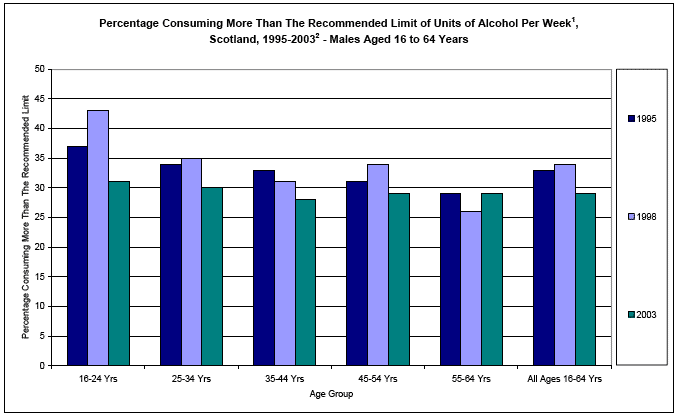
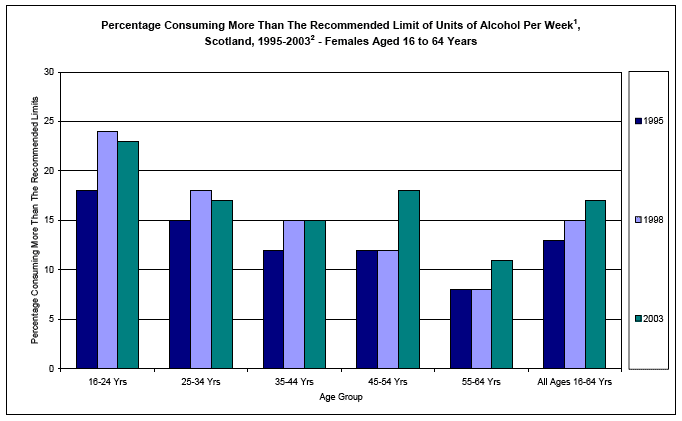
Source: Scottish Health Survey
Notes: 1. Some examples of what one unit of alcohol is equal to are; Half a pint of ordinary strength beer, lager, or cider (3-4% alcohol by volume), or a small pub measure (25 ml) of spirits (40% alcohol by volume), or a standard pub measure (50 ml) of fortified wine such as sherry or port (20% alcohol by volume). There are one and half units of alcohol in the following examples; a small glass (125 ml) of ordinary strength wine (12% alcohol by volume), or standard pub measure (35 ml) of spirits (40% alcohol by volume).
2. Figures for 2003 are the latest published.
Publications
Social Focus on Women and Men 2002 http://www.scotland.gov.uk/stats/sfwm/docs/sfwm-00.asp
Scottish Health Survey, 2003 http://www.scotland.gov.uk/Publications/2005/11/25145024/50251
Sexual Health
Sexual Health: Age & Gender
Since 1996, there has been an upward trend in numbers of diagnoses of sexually transmitted infections ( STIs) in Scotland for both males and females, particularly for younger age groups.
The incidence of STIs has increased by more than 80% for both males (up from 6,292 in 1996 to 11,497 in 2005) and females (up from 4,627 in 1996 to 8,641 in 2005). In 2005, 57% of diagnoses were for males and 43% were for females. There has been little variation in this ratio since 1996.
The incidence of STIs for females is highest for those aged 20 to 24 years (37% of all female diagnoses) in 2005. The incidence of STIs for males is also highest for those aged 20 to 24 years in 2005 (37% of all male diagnoses), with the incidence amongst this age group increasing substantially since 1996.
Between 2000 and 2005, the most marked increase in incidence of STI's occurred for both men and women aged between 15 to 19 years and 20 to 24 years.
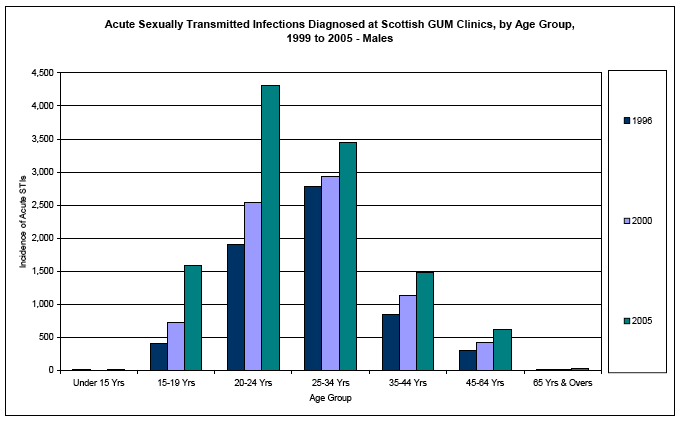
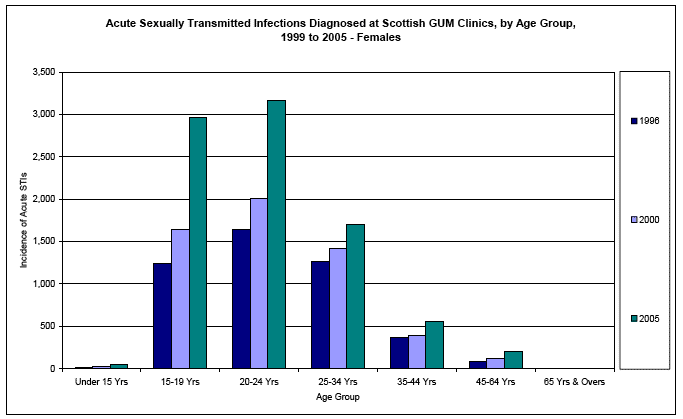
Source: Information Services Division ( ISD)
Publication
Social Focus on Women and Men 2002 http://www.scotland.gov.uk/stats/sfwm/docs/sfwm-00.asp
Web Link
Scottish Health Statistics - Sexual Health http://www.isdscotland.org
Dental Health
Dental Health: Age
The proportion of adults registered with the General Dental Service ( GDS) 1 has decreased very slightly in the past five years, however it remains virtually unchanged for children.
The proportion of all adults registered with the GDS is 48% in 2005, compared to 50% in 2000. Slightly fewer adults aged between 18 and 44 years are registered with the GDS in 2005 compared to 2000 but the reverse is true for adults aged between 55 years and over.
In 2005, the proportion of all children registered with the GDS is 66% and this was also the case in 2000. During this time there has been little variation in the proportion of children registered with the GDS for each age group.
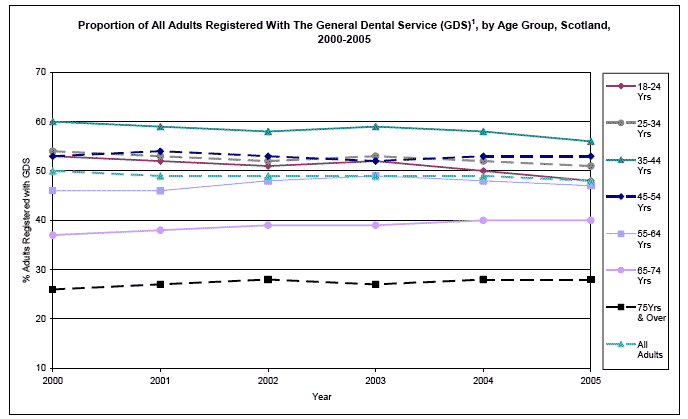
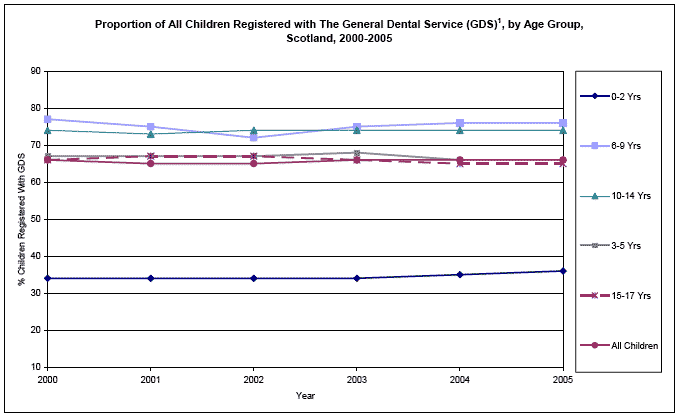
Source: Information Services Division ( ISD)
Note: 1. The NHS General Dental Service ( GDS) is usually the first point of contact that patients have with dental treatment.
Publications
Information Services Division ( ISD) http://www.isdscotland.org
Dentistry In The New Millennium (2002) http://www.scotland.gov.uk/Publications/2002/04/14431/1887
Mental Health
Mental Health: Gender
Psychosocial health is measured in the Scottish Health Survey by the General Health Questionnaire ( GHQ12). This is a widely used standard measure of mental distress and psychological ill-health. Overall scores ranged between 0 and 12. A score of four or more indicates the presence of a possible psychiatric disorder, whilst a score of zero could, in contrast, be considered to be an indicator of psychological well-being.
The proportion of men with high GHQ12 scores (4+) has remained constant over time at 13%, while it declined slightly for women, from 19% in 1995 and 1998 to 17% in 2003. However, there is a marked increase in the numbers with zero scores, for males this increased from 60% in 1995 to 68% in 2003 and for females this increased from 55% in 1995 to 61% in 2003.
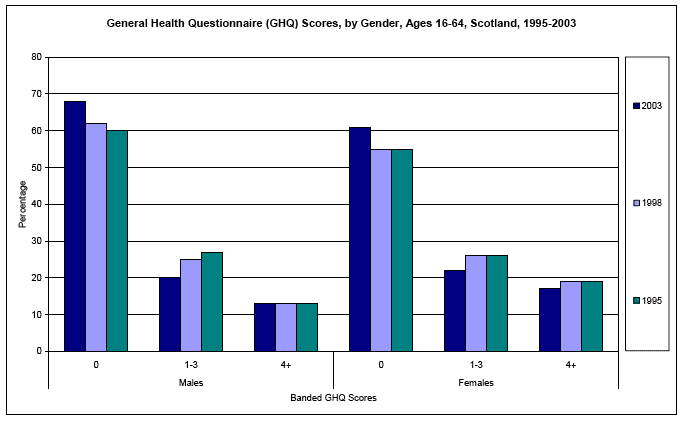
Source: Scottish Health Survey
Publications
Social Focus on Women and Men 2002 http://www.scotland.gov.uk/stats/sfwm/docs/sfwm-00.asp
Scottish Health Survey, 2003 http://www.scotland.gov.uk/Publications/2005/11/25145024/50251
Web Link
Scottish Executive National Programme for Improving Mental Health and Well-Being http://www.scotland.gov.uk/Topics/Health/health/mental-health/NationalProgramme
Shifting the Balance of Care
Delivering for Health sets out a strategy for shifting the balance of care, which will see services provided as locally as possible in a variety of different settings. As part of this there has been a shift in the balance of care from institutional to home-based settings in order to enable more people to live and be cared for in their own homes. This will not only help those who wish to remain in their own homes but should reduce the number of people inappropriately admitted to hospital and care settings.
Care Homes
Since 2003, the number of long stay care home residents aged 16 years and over had fallen by almost 1,000 (2.5%) from just under 38,000 to around 37,000 in 2005.
Care Homes: Disability
Since 2000 the number of residents in care homes for adults with learning disabilities has fallen from over 3,300 to over 2,500 (a drop of 24%). During the same period the number of residents in care homes for adults with physical disabilities has also dropped from 723 to 488 (a drop of 33%) and the number of residents in care homes for adults with mental health problems increased slightly (by around 50 residents or 3%).
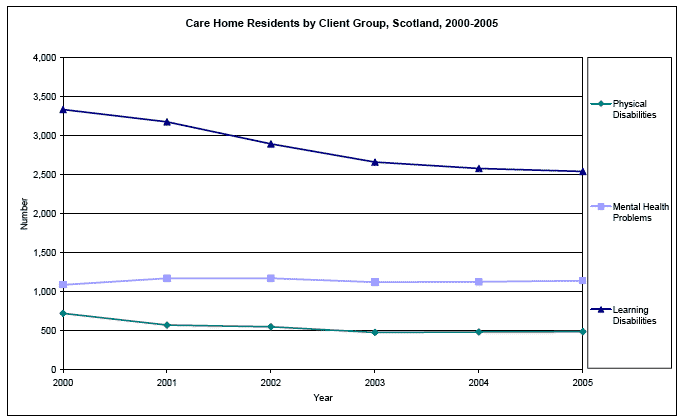
Source: Care Homes, Scotland September 2005
Publication
Care Homes, Scotland September 2005 http://www.scotland.gov.uk/Publications/2006/03/14105932/0
Care Homes: Ethnic Group
The number of care home residents from minority ethnic backgrounds has remained stable at roughly 0.5% between 2003 and 2005.
Source: Care Homes, Scotland September 2005
Publication
Care Homes, Scotland September 2005 http://www.scotland.gov.uk/Publications/2006/03/14105932/0
Care Homes: Age & Gender
Over the period 2003 to 2005 the number of older people (aged 65 years or over) in care homes, which make up 86% of the care home population, fell by almost 900 from the 2003 level of around 33,000. This drop can mainly be attributed to a drop in the numbers of residents aged 85 years and over in care homes with almost 1,000 fewer in 2005 than in 2003.
In 2005, females made up over 70% of the care home population, due mainly to the larger numbers of females aged 75 years and over in care homes. However, between 2003 and 2005 there was a drop in the number of female long stay residents with almost 900 fewer in 2005 than in 2003. This is mainly attributable to the drop in the number of females aged 85 years and over.
The picture for male care home residents is however different with small drops in the number of males for all age groups apart from men aged 75 to 84 years where there was a rise. Overall, this has led to the numbers of male residents remaining relatively stable between 2003 and 2005.
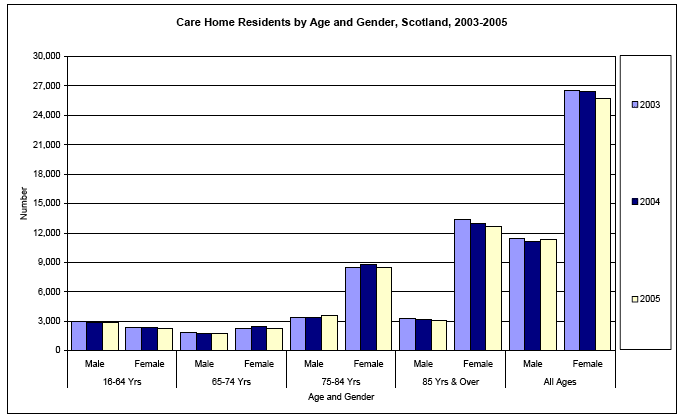
Source: Scottish Executive Health Department, Scottish Care Homes Census
Publication
Care Homes, Scotland September 2005 http://www.scotland.gov.uk/Publications/2006/03/14105932/0
Home Care Services
Since 2003 the number of home care clients had risen by almost 7,000 (11%) to 71,000 from the 2003 level of just over 64,000.
Home Care Services: Learning Difficulties and Mental Health Problems
Since 2000 the number of adults with learning disabilities receiving home care has risen from just under 1,500 to just under 3,000 (a rise of 96%). During the same period the number of adults with mental health problems receiving home care also rose from just over 2,200 to just under 3,000 (a rise of 32%).
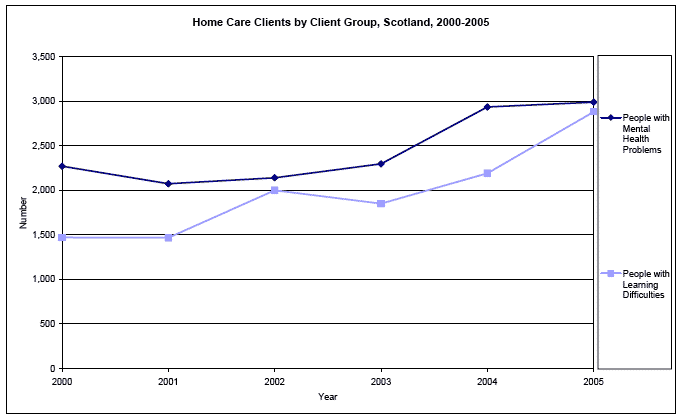
Source: Scottish Executive Health Department, Home Care Census
Publications
Social Focus on Disability 2004 http://www.scotland.gov.uk/Publications/2004/08/19818/41697
Adults with Learning Disabilities: Implementation of The Same as You? Scotland 2005 (Published 2006) http://www.scotland.gov.uk/Publications/2006/05/22101802/0
The Same As You? - a review of services for people with learning disabilities (Published 2000) http://www.scotland.gov.uk/Resource/Doc/1095/0001661.pdf
Home Care Services, Scotland 2005 http://www.scotland.gov.uk/Publications/2005/11/28160037/00376
Home Care Services: Physical Disabilities
The number of home care clients with physical disabilities (including frailty due to old age) has increased by over 10,000 since 2002, to it's 2005 level of just over 57,500. This has been largely driven by the rise in the number of people aged 65 and over in this category with an increase of almost 9,000 since 2002, mainly due to the introduction of Free Personal Care in July 2002.
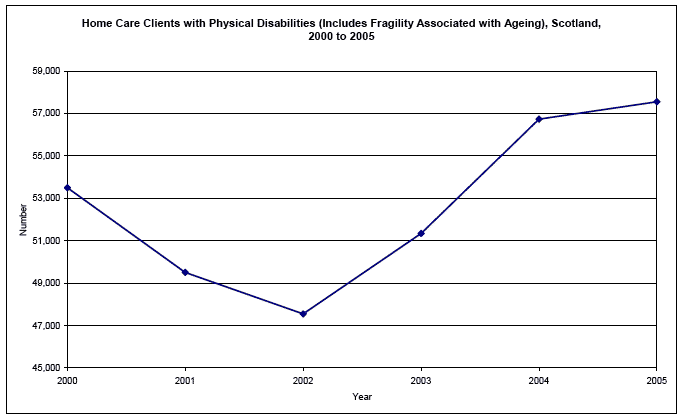
Source: Scottish Executive Health Department, Home Care Census
Publications
Social Focus on Disability 2004 http://www.scotland.gov.uk/Publications/2004/08/19818/41697
Home Care Services, Scotland 2005 http://www.scotland.gov.uk/Publications/2005/11/28160037/00376
Home Care
Home Care: Age and Gender
Between 2003 and 2005 there was an increase in the number of home care clients in each age group with the exception of the 0 to 15 year age group in which there was a small drop. In 2005, roughly 58,000 home care clients were aged 65 or over, this was an increase of over 2,000 from the 2003 level of around 56,000. The biggest increase occurred in the 16 to 64 year age group with over 1,000 more males and 800 more females in this age group in 2005 than in 2003. There were also increases of over 900 and 750 in the 75 to 84 years and 85 years and over age groups.
In 2005, females made up 70% of all home care clients, due mainly to the large numbers aged 75 years and over.
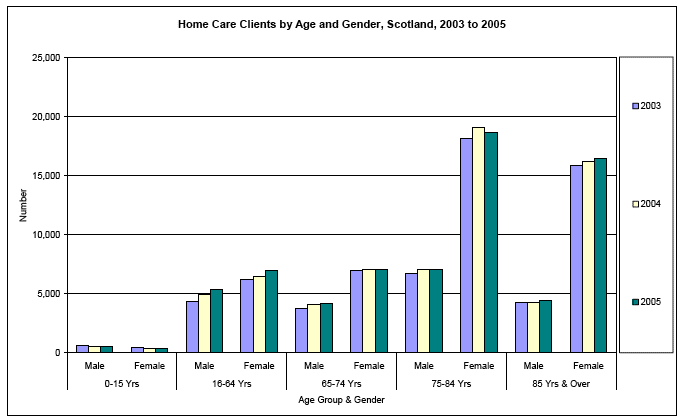
Source: Scottish Executive Health Department, Home Care Census
Publication
Home Care Scotland 2005 http://www.scotland.gov.uk/Publications/2005/11/28160037/00376
Further Information/ Research on Ethnic Groups and Health
Black and minority ethnic health and wellbeing in Greater Glasgow NHS Board http://library.nhsgg.org.uk/mediaAssets/library/nhsgg_report_bme_health_and_wellbeing_summary.pdf
Ethnicity and Health in Scotland: Can We Fill the Information Gap? A Demonstration Project Focusing on Coronary Heart Disease and Linkage of Census and Health Records - (Published by University of Edinburgh) http://www.chs.med.ed.ac.uk/phs/research/Retrocoding%20final%20report.pdf
National Resource Centre for Ethnic Minority Health http://www.nrcemh.nhsscotland.com/publications.html
Self-Harm and Suicide Amongst Black and Minority Ethnic Women - A Conference Report (Published by Glasgow Violence Against Women Partnership) http://www.gvawp.org.uk/Resources/pdfs/Self-harm-and-suicide-among-BME-women.pdf
Translation, interpreting and communication support: a review of provision in public services in Scotland http://www.scotland.gov.uk/Resource/Doc/90506/0021781.pdf
There is a problem
Thanks for your feedback